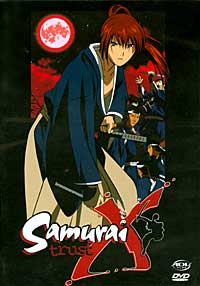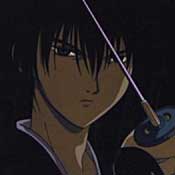|
In September ADV films released the OAV series of "Rurouni Kenshin" on DVD and VHS under the title "Samurai X." Considering that the word "rurouni," which is used by Kenshin to describe himself, combines the words "rurou" (wanderer) and "ronin" (masterless samurai), and that the physical attributes of Kenshin are based nominally upon the form and fighting style of the historical samurai Kawakami Genzai, also known as a hitokiri (mankiller) battousai (sword-master) for his role as an assassin, ADV could hardly have expected that the title (though having already met with static when Sony used it for the television release in southern Japan) would come as a surprise to their American audience. They were wrong. Newsgroups, chatrooms, and message boards gave voice to fans' bewilderment.
"It's one of our hottest sellers. It spent a lot of time on the Billboard charts," notes Ken Wiatrek, marketing coordinator for ADV Films. "'Rurouni Kenshin' is a very cool title for the Japanese," Wiatrek continues. "For Americans, they're not going to run out and go get that. 'Samurai X' is a pretty cool name for Americans to latch on to - its an easy name for Americans to latch on to - they're familiar with the image. There were people that were upset about us calling it 'Samurai X.' That's why we kept it 'Rurouni Kenshin' for the subtitled version. We felt that the ones who wanted 'Rurouni Kenshin' would go that way. But familiarity is important." But the title "Samurai X" may reveal even more about the fusion of Japanese and American fiction and, most importantly, the role that the evolution of the samurai icon plays in that fusion. Film critic Roger Ebert wrote that current Japanese culture is the beta-test version of American culture in the twenty-first century. Ironically, if "Samurai X" is any indication of Japan's current zeitgeist, then by the time it gets here that culture may be a surprisingly American one. According to certain scholars, Kenshin is not a samurai because he has not been born into the samurai class. But in 1860's Japan, anyone who wielded a sword could have been regarded a samurai and history is packed with examples of people not born into the class becoming samurai through exceptional circumstances. Also, evolving literary and philosophic perceptions have offered alternatives to the traditional definition of samurai. The discourse over "Samurai X" became heated with some irate fans offering vast, and oftentimes contradictory, histories of Japanese warriors as arguments against the use of "Samurai" in the title. However, in a literary and artistic context, a samurai has more poetic connotations, and historically the position of samurai is far muddier a concept than that touted by cultural purists. The samurai name and image retains immense iconographic power in Japan and to admirers of Japanese culture. They conjure to mind a noble, proud member of an elite social class who embodied the finest attributes of Japanese tradition, culture, and philosophy. This notion of the samurai springs primarily from the peaceful years of the Edo period. During other periods of Japanese history the samurai were soldiers, and wars have rarely been fought by saints. Ironically, Kenshin may be closer to the reality of the samurai than its popular image.
The arguments advanced against Kenshin's status as a samurai spring from a familiarity with the mythos of the samurai, not the history. Samurai (from samurau - one who serves) were the warrior class of Japan. Kenshin is a warrior. After 1592 ("Samurai X" takes place in the 1860's) only samurai were allowed to carry katana (longswords). Kenshin almost never appears without one. Samurai are not thought of as assassins although hundreds of the samurai who fought in the Baku matsu (end of the Edo period, a time of unrest) were referred to as Hitokiri. Kenshin is irrefutably an assassin. Samurai served as soldiers for their daimyô (lord), shôgun, or emperor. Kenshin works as a soldier on behalf of Ishin Shishi to restore the emperor to power and, though he does so out of his own free will, the lord/servant dynamic is quite pronounced. Kenshin chooses which side to fight for in the war. The mythos surrounding the samurai asserts that they were supposed to serve their masters regardless of their own feelings. This point in particular is well refuted by an essay at www.pvv.ntu.no/~leibakk/mythos.samurai.html: "And yet almost all of Nippon's major battles were decided in large part by sudden defections and backstabbings. The major daimyôs all knew this and made allowance for it happening, because it was so common. If a samurai saw a chance to gain more land by switching sides, they often did so without hesitation � In fact some samurai families split down the middle to ensure that enough of the family would end up on the winning side to survive (and be able to pardon their relatives in the losing camp)." And another Japanese history website, home.owc.net/~dturk/japanhistory/japanhistory.html, illuminates how the reality of the samurai strays from its mythos in other ways: "1716 - Ietsugu dies, thus ending the Hidetada and Iemitsu line of shôguns. Yoshimune, the daimyô of Kii, becomes the eighth Shôgun. Thinking that the samurai class had tilted too far towards learning and leisure, and away from the martial arts and discipline, he frequently issues edicts demanding frugality and self discipline." Kenshin was not born into the samurai class. Historically, thousands of samurai were not born into the class. The samurai date back to 792 AD when professional full-time soldiers, the "Kondei" (Stalwart Youth), were enlisted from amongst the sons of respected families to lead and train what had previously been an army largely consisting of conscripted peasants. Excluding monks, beggars and the aristocracy, Japanese society eventually was loosely organized into four classes: peasants, merchants, artisans, and samurai, with the samurai class including government officials, military leaders and foot soldiers (also known as bushi). During times of peace the samurai were defined as much by heredity as profession, but samurai died by the thousands during times of war demanding others, regardless of heredity, to take up arms. But even in times of peace the status of samurai transcends heredity. English historian George Sansom recognizes such instances in his "A History of Japan: 1615-1867." "Some [samurai], for want of funds, went so far as to adopt the son of a townsman in return for a cash payment, thus conferring upon him the states of samurai," Sansom writes. "There was a recognized scale of payment for these transactions - some twenty ryo to become an ashigaru [lowest rank of samurai, equivalent to a foot soldier], and a thousand ryo or more for higher ranks." |

